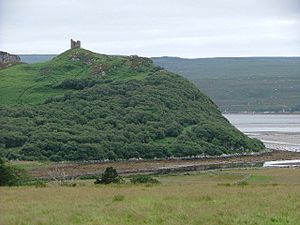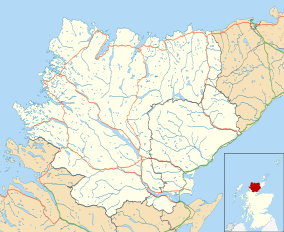Kyle of Tongue facts for kids
Quick facts for kids Kyle of Tongue National Scenic Area |
|
|---|---|

Ben Loyal on the west side of Kyle of Tongue.
|
|
| Location | Sutherland, Highland, Scotland |
| Area | 245 km2 (95 sq mi) |
| Established | 1981 |
| Governing body | NatureScot |
The Kyle of Tongue (which means Caol Thunga in Scottish Gaelic) is a shallow sea loch in the northwest of Scotland. It is located in the western part of Sutherland in the Highland area. This sea loch has a rocky coastline. Its opening to the sea is called Tongue Bay.
The village of Tongue is found on the eastern side of the Kyle. A bridge and a causeway, known as the Kyle of Tongue Bridge and Causeway, cross the loch.
The Kyle of Tongue and the land around it are part of the Kyle of Tongue National Scenic Area. This is one of 40 such areas in Scotland. These areas are chosen because they have incredibly beautiful scenery. They are protected to make sure they stay special and are not harmed by new buildings or changes. This protected area covers about 245 square kilometres. It includes the nearby mountains of Ben Hope and Ben Loyal, along with several small islands and the coastline stretching east to Bettyhill.
Contents
History of the Kyle of Tongue

The Kyle of Tongue has a long history. An old square tower called Castle Varrich stands on a hill on the east side of the Kyle. People believe it was once the home of a leader named Karl Hundason. He tried to take over Scotland after King Malcolm II died.
You can also find three ancient round houses, called brochs, in the area. One is on the east side of the Kyle, across from Melness. Another is at the very end of the Kyle. The third is at Dunbuie, a hill on the west side.
The Battle of Kyle of Tongue (1746)
A famous naval battle happened here in 1746 during the Jacobite rebellion. This was a time when Bonnie Prince Charlie was trying to become king of Scotland and Britain.
A Jacobite ship named Le Prince Charles was bringing a lot of French gold. This gold was meant to help the Jacobite army. British ships were chasing it. On February 25, 1746, one of the British ships caught up with Le Prince Charles in the Kyle of Tongue.
A fierce battle lasted for five hours. The Jacobite ship fought bravely, but it was eventually defeated. The gold never reached Prince Charlie's army. This loss of money was a big reason why the Jacobites lost the Battle of Culloden later that year.
Geography of the Kyle of Tongue
The Kyle of Tongue is located about 8 miles east of Loch Eriboll. Its western entrance is between two places called Cnoc Glass and Roan Island. The eastern entrance is between Rosin Island and Neave Island.
From Roan Island, the Kyle stretches south and southwest for about 7 miles to Kinloch. A large part of the loch is sandy. There is a narrow channel that runs through it. The water depth changes from about 18 fathoms (around 33 metres) near Roan Island to 5 fathoms (about 9 metres) further in. There is no channel for boats along the western shore of the Kyle.
Derry, also known as Loch an Dithreibh, is a lake that flows into the very end of the Kyle of Tongue. A stream called Strathtongue, which is about 8 miles long, also runs into the Kyle.
Wildlife of the Kyle of Tongue
The hills around the Kyle of Tongue are covered with meadows, grasses, and heath. There is also moorland between the Kyle and Loch Eriboll. Much of this area is protected as part of the Natura 2000 network. This means it is a very important place for nature. It is part of the Caithness and Sutherland Peatlands, which are protected as a Special Protection Area and a Special Area of Conservation.
Animals in the Kyle
The waters of the Kyle are home to fish like salmon and sea trout. At the mouth of the loch, you might spot larger sea animals such as whales and otters.
Many different types of birds live in the area. These include barn swallows, black-headed gulls, ravens, redshanks, and wood pigeons. You can also see herring gulls, collared doves, curlews, and oystercatchers. Other birds include golden plovers, great black-backed gulls, cormorants, and grey herons. Look out for greylag geese, house martins, house sparrows, meadow pipits, common gulls, red-throated divers, and rock pigeons.
The Kyle of Tongue is also home to several types of raptors. These powerful hunting birds include golden eagles, hen harriers, merlins, and short-eared owls.
Land Ownership
The land around the Kyle of Tongue is owned by different people. Much of the land on the western and southern sides of the Kyle belongs to a Danish billionaire named Anders Holch Povlsen. This includes the mountains of Ben Hope and Ben Loyal, and a large house called Kinloch Lodge which was once used for hunting.
The land on the eastern shore of the Kyle is part of the very large estates owned by the Countess of Sutherland. The current Countess is Elizabeth Sutherland, 24th Countess of Sutherland.


